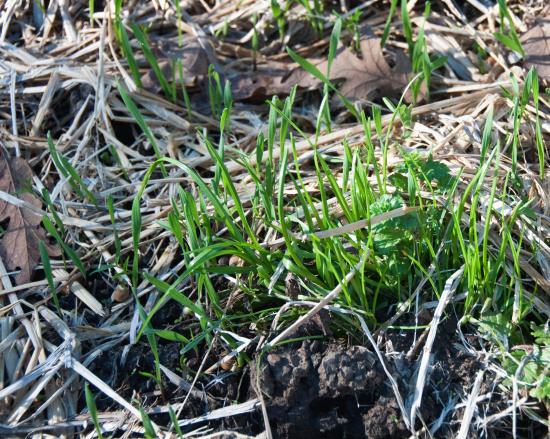
Seeds sprout in late November amoung leaves and rice straw which provide mulch for this year’s cover crop.
A Guest Gardening Post by Robert Gale:
As the 2013 growing season winds down, let’s talk about putting our garden’s to bed for the winter. With a rich history of home-steading, gardening, and farming, many residents of Humboldt County are no doubt familiar with the year-round maintenance of their growing spaces. While some folks maintain a variety of edible winter crops, many others allow their plots to go dormant. Make cover-cropping or mulching part of your fall routine, and get a leg up on next year’s growing season.
“Cover Crops” or “Green Manure” help to suppress weeds, build soil structure, break up sub-soil, fix nitrogen, and can even help control pests and diseases. Another benefit, with our heavy winter rains in Humboldt? Erosion control. Building up garden beds entails heavy lifting and hard work. Don’t let it all wash away.
First off, cover crops are easy to grow! Not just for farmers anymore, cover crops can become an integral part of soil maintenance for gardeners and growers of all shapes and sizes. Cover crops will work with raised beds or large planting pots as well as plots of land.
Planting time is now on the north coast. Call your local farm and feed store. This time of year, we use hardy, over-winter plants. Look for a mix with Oats, Vetch, Austrian Winter Peas, Fava Beans, Winter Wheat, annual clovers and the like. The clover, peas, and beans will fix nitrogen, while the other plants provide carbon and bio-mass to the soil. Work the soil with a fork or heavy rake, and broadcast the seeds as soon as you can. Cover the seeds to avoid hungry birds.
With winter moisture, these crops take little maintenance. If you’re in a warmer area, cut or mow the cover crop when it reaches thigh high. Cut back to shin height, leave the clippings as mulch.
Come spring, you’ll want to ‘kill’ your cover crop. Do this when you see the plants start to set seed, or at the latest, about two-three weeks before planting time. Mow the crop low, and let sit a couple days. Then fork or rototill the stalks and root mass into the soil. Give about two-three weeks for the mass to break down before planting.
This will not only help preserve your soil from the previous season, the stalks and roots actually build up your soil as they decompose. Been another good grow season on the North Coast. Take care of that which takes care of you, your soil. A little extra work now will go a long way next spring. Cheers, Humboldt County!
A great reference, from Rodale’s Organic Gardening:They say gardening takes about 5 years to learn and a lifetime to master. Here’s to speeding up the learning curve!
Cover Cropping Basics: How to grow cover crops: Organic Gardening
Note, if you’re in an area that you can’t get any cover crop seed in time, or you don’t have the money to spend, or you think it’s too cold, try “mulching” your beds instead. Leaves, grass clippings, use what’s on hand to cover your beds before the rains hit. An enormous supply of partially decomposing leaves can be found along the edge of most rural roads. Especially easy pickings are the forest service roads with asphalt.
CLICK TO MANAGE